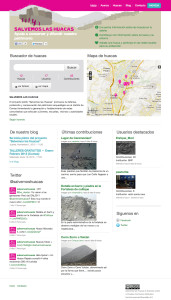On January 2013, Culturaperu.org, La Factura, Alta Tecnología Andina (ATA), el Collectivo Colli and Tándem GCD, a group of organizations interested in cultural heritage and social development, launched the project “Salvemos las Huacas” [Save the huacas] in coordination with the Municipality of Comas and with the support of a mini-grant provided by the Interamerican Development Bank (IDB).
The project aims to use new technologies to sustain and strengthen local networks of students, teachers, public schools and community leaders, aimed at preserving archaeological sites in Lima, Peru. The initiative includes (1) the development of a Website (salvemoslashuacas.pe), (2) a set of workshops on cultural heritage and technologies and (3) the creation of a “Guide” for local educators and promoters. The project aims to develop this first stage as a pilot project, and later replicate this strategy on other districts in the city.
What is a Huaca?
The Encyclopaedia Britannica defines huaca — also spelled wak’a (Quechua: “sacredness,” or “holiness”) — as an ancient Inca and modern Quechua and Aymara religious concept that is variously used to refer to sacred ritual, the state of being after death, or any sacred object.
The Spanish conquistador Pedro de Cieza de León believed that the word meant “burial place.” Huaca also means spirits that either inhabit or actually are physical phenomena such as waterfalls, mountains, or man-made shrines. The aforementioned shrines, which are found throughout the Inca territory from Ecuador to Chile, may be as simple as stones piled in a field (apachitas) or as complex as stepped pyramids that were once topped with canopies and carved images.
— Versión en español en el sitio de Salvemos las Huacas
Photos, Top: Salvemos las Huacas and Sientemag | Right: Screen capture of website.
